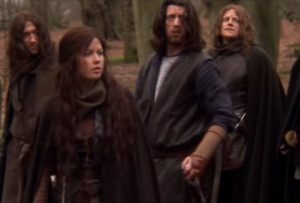Q: What Happened to the Dúnedain after the War of the Ring?
ANSWER: This is an interesting question because even though the reader does not say so I infer that it really means, “What happened to Aragorn’s people (the Dúnedain of the North) after the War of the Ring?” The exact wording is: “At the time of Aragorn’s coronation, how many Dunedain were left and what become of the Dunedain after the war of the ring?”
So let’s talk about who the Dúnedain were and where they lived and what they did. They were originally the peoples of Arnor and Gondor, and they included families that had lived in Middle-earth for generations before Elendil and his sons brought 9 ship-loads of survivors from the ruin of Númenor near the end of the Second Age.

Tolkien seems to suggest that Arnor had the greater population when the Realms-in-Exile were founded, but both kingdoms included in their populations people of mixed descent and people who were not descended from Númenoreans at all. Tolkien never provided numbers for their populations or percentages, so we don’t know how many Dúnedain there were at the start of the War of the Last Alliance of Elves and Men.
We do know that the population of Arnor declined during the Third Age and that the population of Gondor grew for about a thousand years before that realm, too, began to decline. On a couple of occasions Gondor increased its population by accepting Northmen; but the Kin-strife counteracted that growth through civil war, rebellion, and the secession of Umbar from the realm.
There were also “Black Númenoreans” in Middle-earth, descendants of the Kings’ Men who had settled in Middle-earth and thus survived the Downfall. We don’t know how many enclaves they had but Umbar was one of them. Since Gondor conquered Umbar and controlled the haven for a few centuries we have to ask if the Black Númenoreans of Umbar were completely absorbed into Gondor’s population. We know there were still Black Númenoreans living at the end of the Third Age because the Mouth of Sauron was a Black Númenorean. He was not born in the Second Age, as some people suggest, but was a mortal, living man who spent most of his life in Sauron’s service.
With so few facts and already several ambiguities it is impossible for us to determine how many Dúnedain lived in Gondor at the end of the Third Age or what percentage of their population was comprised of Dúnedain.
Aragorn’s people were distinct from the Dúnedain of Gondor only in that there had been little to no interaction between the two groups for about a thousand years. Aragorn’s years of errantries are the only documented interaction between northern and southern Dúnedain.
The company of Rangers who followed Halbarad were not the only Rangers or Eriador living at the time Frodo left the Shire because the Black Riders had slain at least some of the Rangers guarding Sarn Ford in Southfarthing. But were they all that remained of the Rangers? Many a reader has asked this question, and the answer is that we don’t know. Halbarad says the 30 men with him were all the could be gathered in haste, which seems to imply there were others who for whatever reason could not join the company.
When the War of the Ring ended Halbarad was dead but the 30 Rangers were still living. And yet many of Gondor’s Dúnedain also appeared to survive, and Gandalf warned Barliman Butterbur that people would soon be migrating north along the Greenway from the South to repopulate Arnor. We learn in the Appendices to The Lord of the Rings that Aragorn re-established Arnor’s capital at Annúminas. Did all those people come from Eriador, were they all from Gondor, or did they include a mix of Dúnedain from the Angle (where Aragorn’s people lived) and Gondor? We don’t know.
I hazard the guess there were probably still thousands of Dúnedain living in Gondor, and that some of these people moved north to help rebuild Arnor. In one of his letters Tolkien states that at the end of the Third Age there were more people living in Gondor who spoke an Eldarin language than in Lindon, Rivendell, and Lorien combined. I think they had to number in the thousands.
Hence, no matter how small Aragorn’s own population of Dúnedain and Rangers of Eriador may have been, it appears they were reinforced by their kinsmen from the south. That just makes an impossible task (of estimating population) even more impossible.
See also:
- Of Thegns and Kings and Rangers and Things
- How Many Rangers of the North Were There?
- Where Did Aragorn Come From?
- Ranger For Hire: Have Horse, Will Travel
Have you read our other Tolkien and Middle-earth Questions and Answers articles?

I never thought of Gondor. I my mind Dunedain always meant ‘Rangers’. Of course, I was neglecting the largest part of them in my thinking. To reestablish a capitol would require a goodly number of folks so unless every single Dunedain in Angle and some good folk of Bree joined them they would need men from the south. Makes sense to me.
Do you think the Rangers continued in the service of Aragorn after he became king, or would the group have disbanded?
Great response, thanks for answering this question. I wish there was more known about the ranger culture in general for my RPG I’m running but these articles help a lot in fleshing it out.